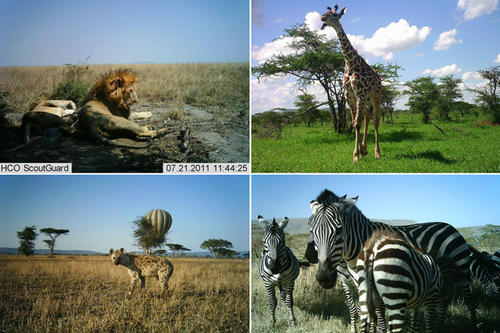
Minneapolis-St. Paul (2/6/2018) - When it comes to wildlife monitoring, a picture is worth more than a thousand words. That is why the University of Minnesota Lion Center launched a new citizen science project today called SnapshotSafari. Through camera-traps, cameras that use passive infrared sensors to take a series of three photographs when a warm object moves in front of the sensor, researchers hope the project will give them a better understanding of wildlife populations and the effectiveness of conservation efforts designed to protect them.
SnapshotSafari’s camera network spans dozens of parks and reserves across southern and eastern Africa. Cameras are in place at regular intervals and generate thousands of photos annually, providing a glimpse into the lives of endangered species and the distribution of wildlife across many different types of landscapes.
“Despite profound challenges in protecting Africa’s remaining wildlife, there are a number of conservation success stories across the continent,” said Dr. Craig Packer, director of the University of Minnesota Lion Center. “The camera trap grids will provide essential data for tracking the population status of all the larger species in each reserve. We will thereby be able to identify the most effective management strategies and help conservation agencies learn from one another’s experiences.”
SnapshotSafari photos are shared online with volunteers, or “citizen scientists,” who record each animal sighting, from lions to topi. This work produces a valuable pool of data for use in monitoring the effectiveness of conservation programs and the response of wildlife to disturbances in their environment, such as drought and wildfires.
In 2010, researchers from the University of Minnesota Lion Center deployed a grid of 225 cameras in Serengeti National Park, Tanzania to monitor the status of lions and other large mammals. It led to the formation of the Lion Center’s first citizen science project, Snapshot Serengeti. Using the Zooniverse platform, more than 140,000 volunteers from around the world logged on to classify millions of wildlife photos by identifying the species, the number of animals photographed, their behavior and whether young were present.
“Researchers from various institutions use the Snapshot Serengeti data to improve our understanding of African wildlife, from ecosystem functions and services to the management of reintroduced and threatened species,” said Packer.
SnapshotSafari is an expansion of the Snapshot Serengeti model. It encompasses many different types of habitat, each with its own unique collection of plants and animals. Camera locations include: South Africa, Mozambique, Swaziland, Tanzania, Botswana, Zimbabwe, and Kenya. Additional sites will be added throughout 2018.
“By collecting data from all of these protected areas in the same way, we will gain a broader understanding of the status of species, like lions, on a continental scale,” said Packer.
This network is made possible by University of Minnesota Lion Center sponsors: Detroit Zoo, Seneca Park Zoo, Zoo Miami, The Living Desert Zoo, the Cincinnati Zoo Angel Fund, and the Oklahoma Zoo. Many of the Lion Center’s partners in Africa are in need of assistance to purchase the cameras for their grids. Individuals wishing to donate in support of these efforts to monitor and conserve wildlife may contribute through the Lion Center.
For updates on SnapshotSafari and the University of Minnesota Lion Center, follow the project on Facebook (@SnapshotSafari and @UofMLionCenter), Instagram (snapshot_safari and umnlioncenter) and Twitter (@SnapshotSafari and @UMNLionCenter).
###
The mission of the University of Minnesota Lion Center is to advance lion conservation through advocacy for direct international funding for African wildlife reserves and development of innovative strategies to protect both lions and vulnerable human communities in an ever-evolving landscape.
The University of Minnesota College of Biological Sciences seeks to improve human welfare and global conditions by advancing knowledge of the mechanisms of life and preparing students to create the biology of tomorrow. Learn more at cbs.umn.edu.
- Categories:
- Science and Technology





